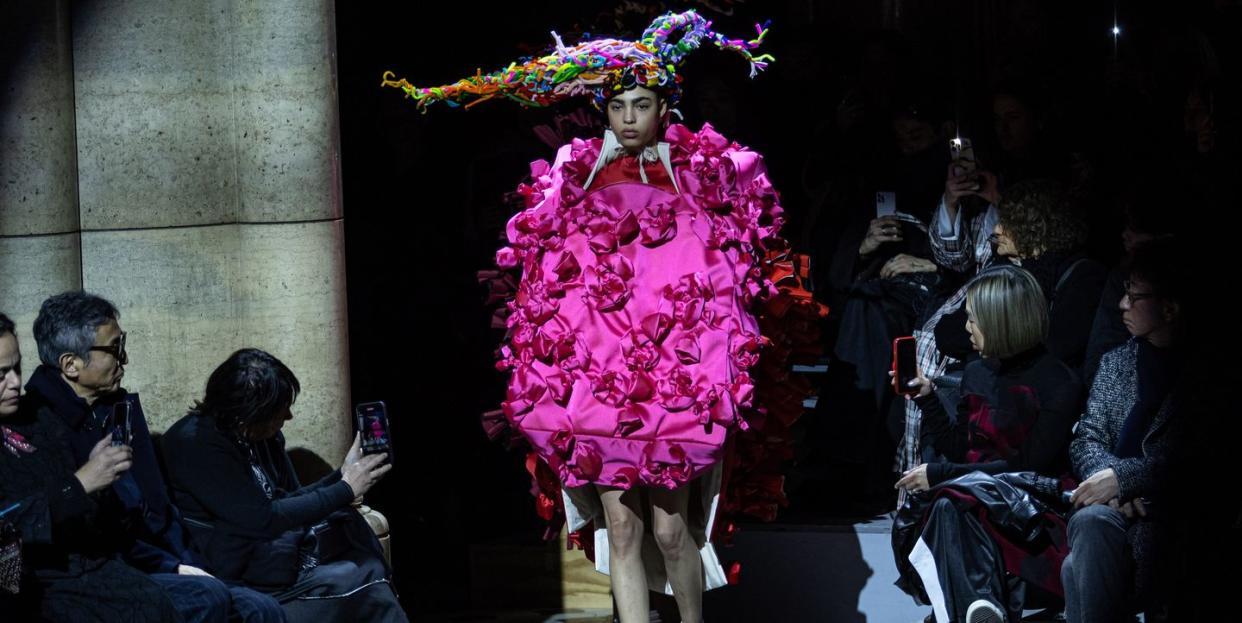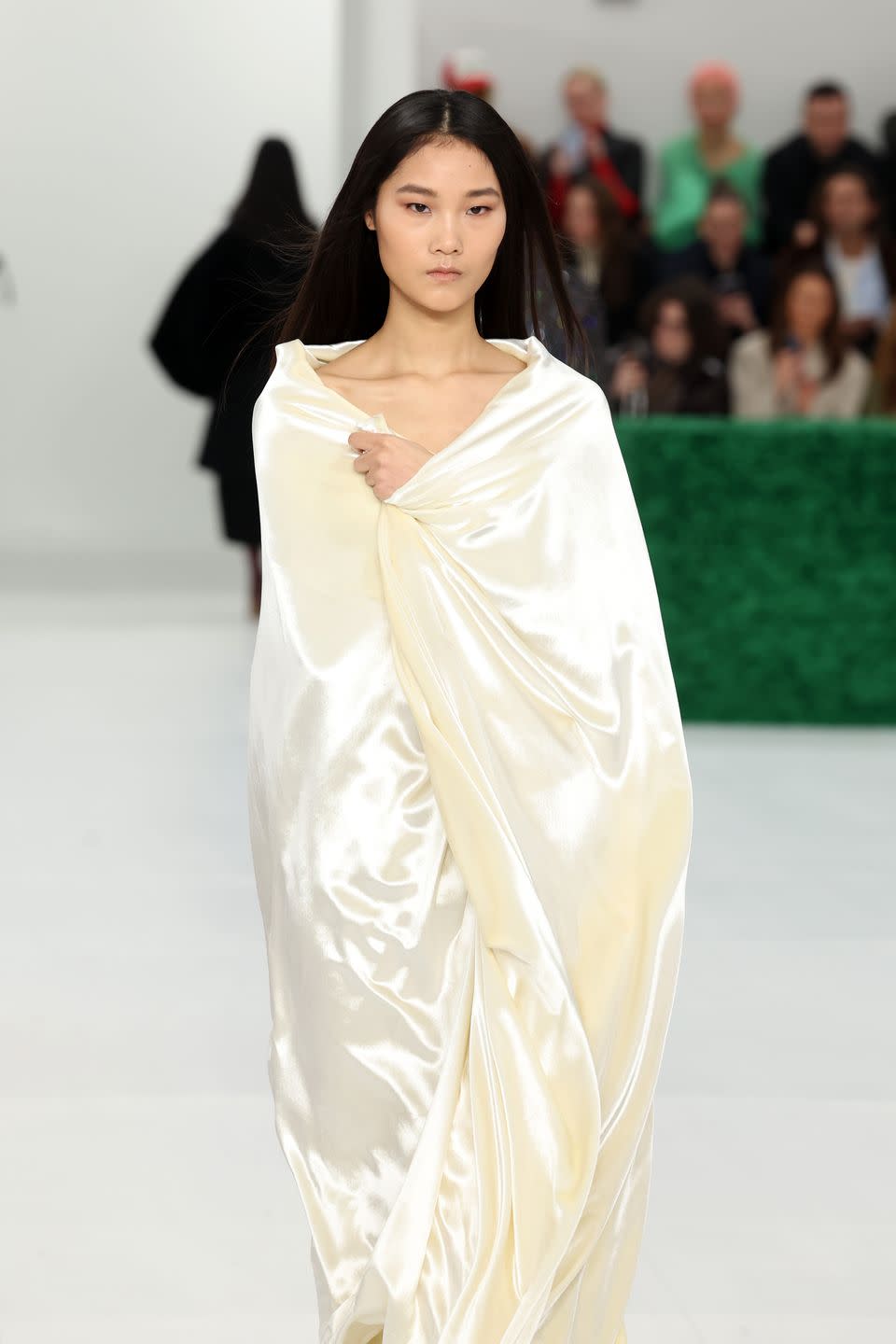Fashion at the End of the World

- Oops!Something went wrong.Please try again later.
Intellectually and artistically, it’s been a strange season. On the runway and backstage, many designers seem to be struggling to know what to say or what moods to articulate. Many seem downright scared to do something bold or provocative, and that has come at the expense of clarity, meaning, and heft. Wearable clothes are good, but they are also a fallback when it’s too much of a risk to create something that might entice or dare customers instead.
One cultural shift and a new reality have created this situation, I think. First, the fear of going too far, or taking any kind of risk at all, has gripped everyone. Designers are often insecure personalities to begin with, and the scalding temperature of the cultural discourse means they are terrified something they do might be misinterpreted or just misunderstood, especially on social media.
On the one hand, it should be clearer to everyone that social media commentary is shaped not by strongly held morals or values; rather, the platforms tend to incentivize the most outrageous or incendiary views. (This is a real disaster for the public intellectual!) On the other hand, that fear might actually be a good thing: it might lead to runway collections and clothes that are more considered. We don’t live in a world anymore where a designer should just seize upon a concept for the season and send their atelier spinning into unquestioned execution, singing “Yes! Yes!” merrily along the way. There has to be more openness to seeing ideas or clothes from multiple perspectives.
Except—and this is the second part—I don’t think designers have time to think about things. The fashion industry has essentially been on the road since the beginning of the year: menswear, then haute couture, now women’s ready-to-wear. Do designers even have time to think? Do they have time to read, or watch movies, or research or gossip? What feels like it’s missing from this season is a sense of discourse or cultural life infused into the clothes. There is little sense that what’s happening on the runway is connected in a larger way to the feelings or concerns or everyday lives (or even one crazy experience!) of the people making or buying things.
Nor is there a feeling that many of the collections are picking up on threads also seizing other forms of culture. That latter phenomenon is where fashion really excels: finding the nuance in something and amplifying it. Brands are relying heavily on the presence of celebrity guests for relevance, because I don’t think they have enough time to create collections that reflect their own lives or some larger truth about our world.

One designer who deals well with a world of uncertainty is Jonathan Anderson, who is in his fourth season of pulling the Jenga bricks out from underneath his quiet, crafty Loewe and replacing it with a wild-eyed and pure, unadulterated weird. He always gives us something meaty to chew on, and though I felt there was a touch too much gristle in this season’s slice, his demand for newness amid everyone’s lust for lionizing the past remains totally original. He goes against fashion’s every instinct. He tends to his creativity like it’s some kind of wonderful romantic partner, tenderly feeding it with Beckett and young painters like Florian Krewer and the big dogs like Gerhard Richter. And then he channels all that into taking a machete to the fashion status quo: well-merchandised, highly styled runways? Chop! Romanticizing history? Chop!! Wearable wardrobe clothes? CHOP!!!
As I wrote last season, his collections will leave you wondering whether what you’re seeing are even clothes, and this season he took that further, into a crazy existential journey about the very purpose of fashion and its relationship to history. One cardigan sweater was actually a sticker. Several of the dresses were draped and sewn pieces of cloth that only became dresses by the defensive gestures of the models. A chain slung from the hem of a short dress was thrown over the shoulder to make it even shorter. Another dress had a knob at the chest with the cloth heaped over it. Anderson, who is 38, seems to be working out in the space of his collections what fashion is and could be. What makes something fashion? At what step in the process of designing does a bolt of fabric become something desirable or meaningful or viral?
Another series of dresses were antique garments (not Loewe’s) printed onto simplistic silk dress silhouettes. Anderson said he’s softening up on incorporating Loewe’s history into his vision of the brand now that he’s been there for a decade, and I loved the idea of putting something old (which usually means “important!”) on something naive. It was so obvious that it created a little fashion enigma. Fashion reveres history, often to its detriment, and it seemed like Anderson was instead offering up his own ambivalence about that. He clearly adores his elders—he seems to be on a big Issey Miyake kick—but less because they are older and wiser, and more because they did punk stuff before and remind him it can be done at a mass scale.
Anderson made a wacky quip backstage about the big white fashion show box space being like a wrestling ring. The ideas get in there, and they fight it out! I thought of that the next day at Comme des Garçons, where Rei Kawakubo brought us into a purpose-built square in one half of the American Cathedral.
Kawakubo’s clothes were flatter and somehow more naive in their shapes (especially compared to last season’s abstracted antique costumes), which made me think of someone a few centuries from now trying to recreate this “fashion” they’ve heard about from all those years ago, and which only survives in a few stray scraps of poor images from piles of nearly-dead iPhones.
A quartet of models lumbered into the space in her soft sculpture-ensembles, with enormous cone wigs on their heads, as Siouxsie & The Banshees played. Spotlights followed them as they walked diagonally and turned and walked back, and once they were just out of the square, the lights and music abruptly shut off. Then another pair entered, walking in a slightly different pattern, to music by Sun-Ra. This repeated over and over, with all different kinds of music, curated by Dover Street Market’s sound artist Calx Vive: Jesse Norman singing Satie, a vampiric-chill song by electronic musician Joey Anderson, a little Rameau, a bit of Can.
Another critic might make connections between the distinctions of the clothes in each scene and the music, but I instead saw a classic Kawakubo comedy about the idiocy of seasonal fashion, in which a mood around a set of clothes blasts forth at full volume, insisting on its immediacy and even urgency, and just as quickly disappears, never to be thought of again. Its relationship to the clothing can be enigmatic; decode references if you wish. So it was like a stuck-out tongue at everyone’s struggle to say something this season: maybe it’s all a farce anyway!
You Might Also Like

